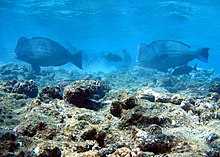Bumphead parrotfish
| Green humphead parrotfish | |
|---|---|
 |
|
| Scientific classification | |
| Kingdom: | Animalia |
| Phylum: | Chordata |
| Class: | Actinopterygii |
| Order: | Perciformes |
| Family: | Scaridae |
| Genus: |
Bolbometopon J. L. B. Smith, 1956 |
| Species: | B. muricatum |
| Binomial name | |
|
Bolbometopon muricatum (Valenciennes, 1840) |
|
The green humphead parrotfish (Bolbometopon muricatum) is the largest species of parrotfish, growing to lengths of 1.3 m (4.3 ft) and weighing up to 46 kg (101 lb). It is found on reefs in the Indian and Pacific Oceans, from the Red Sea in the west to Samoa in the east, and from the Yaeyama Islands in the north to the Great Barrier Reef, Australia, in the south.
Other common names include bumphead parrotfish, humphead parrotfish, double-headed parrotfish, buffalo parrotfish, and giant parrotfish.
It is the only species in the monotypic genus Bolbometopon.
Unlike wrasses, it has a vertical head profile, and unlike other parrotfishes, it is uniformly covered with scales except for the leading edge of the head, which is often light green to pink. Primary phase colouration is a dull gray with scattered white spots, gradually becoming uniformly dark green. This species does not display sex-associated patterns of color change. The adult develops a bulbous forehead and the teeth plates are exposed, being only partly covered by lips. The species is slow-growing and long-lived (up to 40 years), with delayed reproduction and low replenishment rates.
This species is gregarious and usually occurs in small aggregations, but group size can be quite large on seaward and clear outer lagoon reefs, exceeding 75 individuals.
The fish spawn pelagically near the outer reef slope or near promontories, gutters, or channel mouths during a lunar cycle, and they use spawning aggregation sites.
The juvenile green humphead parrotfish is found in lagoons, often in seagrass beds, and the adult is found in clear outer lagoons and seaward reefs up to a depth of 30 m. It feeds on benthic algae and live corals. It may ram its head against corals to facilitate feeding. Each adult fish ingests over five tons of structural reef carbonates per year, contributing significantly to the bioerosion of reefs. The fish sleeps in caves and shipwrecks at night, usually in large groups.
...
Wikipedia

